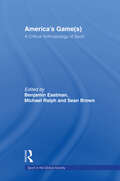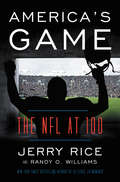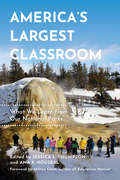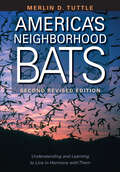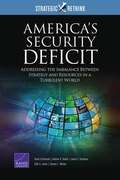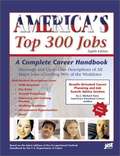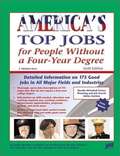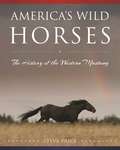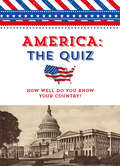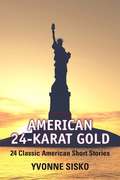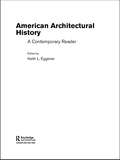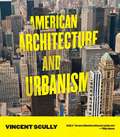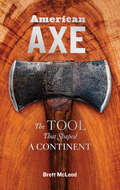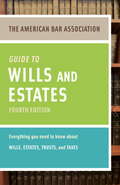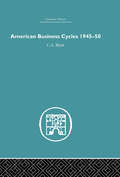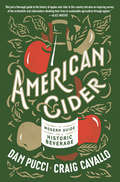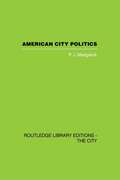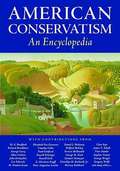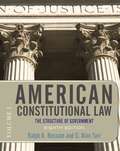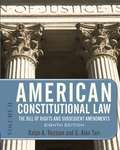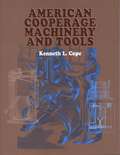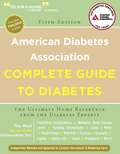- Table View
- List View
America's Game: A Critical Anthropology of Sport (Sport in the Global Society)
by Benjamin Eastman, Michael Ralph and Sean BrownThis insightful volume considers how to locate America in the sporting world: in the traditions and rituals of a national pastime or in the baseball academies run by American professional teams in the Dominican Republic? With the athletes that carry a flag in Olympic ceremonies or among the executives in the boardrooms of Nike? The contributors arg
America's Game: The NFL at 100
by Jerry Rice Randy O. WilliamsA celebration of 100 years of the NFL from Hall of Fame receiver and bestselling author Jerry Rice!“This book is an amazing compilation of the game’s history as seen through the eyes of my friend Jerry Rice, aka The GOAT. You are going to love this book almost as much as you loved watching Jerry play!” —Barry Sanders, NFL Hall of Fame Class of 2004The authors of the New York Times bestseller 50 Years, 50 Moments celebrate the first 100 years of the National Football League, interweaving history, personal stories, memories, and observations of some of its greatest players, coaches, and advocates to chronicle football’s amazing evolution from a fledgling regional fly-by-night operation into a multi-billion global brand and one of America’s leading franchises.Over the past century, professional football has transformed from a game played in leather helmets on cow pastures to one of the most high-tech, popular sports on the planet. In this entertaining and concise history, Jerry Rice and Randy O. Williams celebrate the NFL’s centennial, bringing together colorful memories, insights, and personal experiences and observations from the heroes, losers, innovators, and defining legends who have played the game at its highest level. America's Game is filled with inside stories of the league’s fiercest rivalries, closest competitions, and most memorable characters, from the early days of Red “The Galloping Ghost” Grange and “Slingin’” Sammy Baugh to Jim Brown and “Broadway” Joe Namath to Lawrence Taylor, Jerry Rice, and Tom Brady.Cowboy fans will never forget how Roger Staubach’s Hail Mary lifted his team to a last-second playoff victory over the Vikings. Patriot followers will always point to The Tuck Rule Game as a franchise landmark where Adam Vinatieri’s two clutch kicks in deep snow propelled his team to victory over the Raiders. Generations of Steelers fans will celebrate James Harrison’s electrifying 100–yard interception return for a touchdown in Super Bowl XLIII. All are among the most memorable moments in NFL history. Divided by increments of twenty-five years, each section of America's Game includes the authors’ selections for their “All Star” players and teams.America's Game is a unique tribute to this enduring cultural phenomenon, and will become the authoritative tribute to all that is great about the sport Americans—and the world—loves.
America's Largest Classroom: What We Learn from Our National Parks
by Jessica L. ThompsonOver the past 100 years, visitor learning at America’s national parks has grown and evolved. Today, there are over 400 National Park Service (NPS) sites, representing over eighty million acres. Sites exist in every US state and territory and are located on land, at sea, in remote areas, and in major urban centers. Every year, more than 300 million people visit national parks, and several million of them are children engaged in one of many educational programs hosted by the NPS.America’s Largest Classrooms offers insight and practical advice for improving educational outreach at national parks as well as suggestions for classroom educators on how to meaningfully incorporate parks into their curricula. Via a wide collection of case studies—ranging from addressing inclusivity at parks and public lands to teaching about science and social issues—this book illustrates innovations and solutions that will be of interest to nature interpreters, outdoor educators, and policy makers, as well as professors in the sciences writ large.
America's Neighborhood Bats: Understanding and Learning to Live in Harmony with Them (Revised Edition)
by Merlin D. TuttleA guide to these frequently misunderstood animals that dispels unnecessary fears and encourages an appreciation of bats and their conservation needs. Since its publication in 1988, America&’s Neighborhood Bats has changed the way we look at bats by underscoring their harmless and beneficial nature. In this revised edition, Merlin Tuttle offers bat aficionados the most up-to-date bat facts, including a wealth of new information on attracting bats and building bat houses and a revamped key to the identification of common North American species. The easy-to-understand text, clear illustrations, and spectacular color photographs make this the perfect bat book for the general reader, as well as an invaluable resource for professionals who field questions from the public. Those who provide advice at health and animal control departments, museums, zoos, and nature centers will find it especially useful.
America's Security Deficit: Addressing the Imbalance Between Strategy and Resources in a Turbulent World
by Seth G. Jones Andrew R. Hoehn James T. Quinlivan David Ochmanek Edward L. WarnerThis report analyzes defense options available to the United States in responding to current and emerging threats to U. S. security and interests in Europe, the Middle East, and Asia. It focuses on ways that the United States might adapt military instruments to meet these emerging challenges, assessing in broad terms the cost of defense investments commensurate with the interests at stake.
America's Top 300 Jobs, Eighth Edition: A Complete Career Handbook
by Michael FarrThe job descriptions and other information in this book are based on extensive research by the U.S. Department of Labor. The well-written text covers all major jobs held by about 90 percent of the workforce. Each description is packed with details, including skills required, education and training needed, working conditions, salaries, advancement opportunities, future growth, related jobs, and much more. This book's content offers practical information for career planning in an easy-to-use format. You can use the table of contents to quickly identify jobs that interest you. You will find all major occupations listed there and arranged within groups of similar jobs. And the "Tomorrow's Jobs" section provides a brief, helpful overview of labor market and industry trends. The right job can make an enormous difference in your career success and satisfaction. Whether you're exploring career or educational options, looking for a new job, or advancing in your career, this book will help. Employers, career counselors, and other professionals can also use its authoritative content for determining average wages, writing job descriptions, and accomplishing other important purposes.
America's Top Jobs For People Without A Four-Year Degree: Sixth Edition
by Michael FarrAmerica's Top Jobs for People Without a Four-Year Degree describes 190 major occupations that do not require a four-year degree. Knowing more about these jobs can help you plan your training and education, make a career choice or change, or find work with higher pay and more advancement potential. Each description includes details about the following: Significant Points Nature of the Work Working Conditions Employment Training, Other Qualifications, and Advancement Job Outlook Earnings Related Occupations Sources of Additional Information
America's Wild Horses: The History of the Western Mustang
by Steve PriceThere is no creature that quite embodies the beauty and grandeur of the American West as does the wild horse. For thousands of years, the horse has roamed the plains and valleys of the American continent, free of the encumbrances of man or the saddle. In America’s Wild Horses, award-winning photographer and lifelong horse lover Steven Price celebrates the timeless magnificence of the American mustang.Meticulously researched, Price offers a cultural history of the American wild horse that is unparalleled in its exquisite detail and poignant prose. Beginning with chapters on prehistoric equines, Price sweeps through all the most important historical epochs in the history of the American mustang. Detailed accounts of horse-breeding in the Southwest, Native American horsemanship, and mustangs in the golden age of the iconic American cowboys each detail the profound impact that the wild horse has had in shaping American culture. Later chapters chronicle the legacy of the horse in the twentieth and twenty-first centuries, specifically emphasizing the legal and scientific measures that are being taken by horse-lovers across the country to ensure that later generations will also be able to witness the majesty of the wild horse.Featuring dozens of stunning photographs by the author, and interspersed with firsthand interviews with some of the most renowned horse experts today, America’s Wild Horses is a required read for all equine lovers.
America: How Well Do You Know Your Country?
by Union Square & Co.Would you pass the government&’s test to become an American citizen? Take the 100-question quiz and see! As millions of people know, becoming an American citizen isn&’t easy. It involves a lengthy application process, including a tough two-part naturalization test covering English and civics. How well would you do? Find out! America: The Quiz contains the most updated version of the 100 test-prep questions given to applicants by US Citizenship and Immigration Services, current through the 2016 elections. They include: What is an amendment?What is &“the rule of law&”?What does the president&’s cabinet do?Name three of the original 13 statesName one state that borders CanadaWhy does the flag have 50 stars? A surprising number of questions require even more advanced knowledge. For example: Describe one of the four Constitutional amendments concerning the right to vote. Complete with illustrations and historic photographs, and fully updated through the presidential election of 2016, America: The Quiz is a handy little guidebook to the nation you thought you knew.
American 24-Karat Gold: 24 Classic American Short Stories (4th Edition)
by Yvonne Collioud SiskoThe book presents a selection of 24 classic American short stories. From popular authors such as Mark Twain, Langston Hughes, and Zora Neale Hurston, the stories included in the book become easier to understand with pro-reading questions, vocabulary exercises, and biographical headnotes.
American Architectural History: A Contemporary Reader
by Keith Eggener<p>This major new text presents a collection of recent writings on architecture and urbanism in the United States, with topics ranging from colonial to contemporary times. In terms of content and scope, there is no collection, in or out of print, directly comparable to this one. The essays are drawn from the past twenty years' of publishing in the field, arranged chronologically from colonial to contemporary and accessible in thematic groupings, contextualized and introduced by Keith Eggener. <p>Drawing together 24 illustrated essays by major and emerging scholars in the field, American Architectural History is a valuable resource for students of the history of American art, architecture, urbanism, and material culture.</p>
American Architecture and Urbanism
by Vincent ScullyA classic book authored by the foremost architectural historian in America, this fully illustrated history of American architecture and city planning is based on Vincent Scully's conviction that architecture and city planning are inseparably linked and must therefore be treated together. He defines architecture as a continuing dialogue between generations which creates an environment across time. This definitive survey extends beyond the cities themselves to the American scene as a whole, which has inspired the reasonable balanced, closed and ordered forms, and above all the probity, that he feels typifies American architecture.
American Architecture and Urbanism
by Vincent ScullyA classic book authored by the foremost architectural historian in America, this fully illustrated history of American architecture and city planning is based on Vincent Scully's conviction that architecture and city planning are inseparably linked and must therefore be treated together. He defines architecture as a continuing dialogue between generations which creates an environment across time. This definitive survey extends beyond the cities themselves to the American scene as a whole, which has inspired the reasonable balanced, closed and ordered forms, and above all the probity, that he feels typifies American architecture.
American Axe: The Tool That Shaped a Continent
by Brett McLeodFrom bronze axes of the Viking conquests to the American homesteader&’s felling axe, this is a tool that has shaped human history like few others. American Axe pays tribute to this iconic instrument of settlement and industry, with rich history, stunning photography, and profiles of the most collectible vintage axes such as The Woodslasher, Keen Cutter, and True Temper Perfect. Combining his experiences as a forester, axe collector, and former competitive lumberjack, author Brett McLeod conveys the allure of this deceptively simple woodcutting implement and celebrates the resurging interest in its story and use.
American Bar Association Guide to Wills and Estates, Fourth Edition
by American Bar AssociationThe American Bar Association Guide to Wills & Estates, Fourth Edition, is the user-friendly guide that contains everything you need to know about planning an estate and preparing a will. It is organized in easy-to-follow chapters with sidebars containing tips, checklists, and key information, encouraging you to begin the process quickly and easily.The ABA Guide to Wills & Estates will help you:* Determine what to put in an estate plan* Decide whether to prepare a will, trust, or living trust* Avoid or reduce estate taxes* Transfer property without a will with substitutes such as life insurance and joint tenancy* Understand the benefits of living gifts and life insurance, among many other topics The Fourth edition features new and updated topics, such as: * Life-threatening and chronic illnesses* Incorporating your religious beliefs into your estate plan * Assisted reproduction and its resulting estate planning implications* Civil unions and same-sex marriages* Elder abuse and care* Information about Roth IRAs in estate plans* The impact of digital assets on estate planning
American Business Cycles 1945-50
by Conrad BlythAfter the end of the Second World War businessmen and economists throughout the world feared that the American postwar inflationary boom would end in a serious slump. The slump took a long time to come, and when it did appear in 1949 it was both mild and short lived. In its mildness and brevity it foreshadowed the American business recessions since that time and, indeed, may foreshadow the end of the business cycle as it has been known in the past. This book presents the first full-scale study of the 1948–49 recession in the United States, making it the focal point of a detailed, analytical account of American business fluctuations from the end of the Second World War until the beginning of the Korean War. The main part of the book is prefaced by a review of fluctuations from 1945 to 1967 and of the business cycle theory, which places the postwar events in perspective. Of special importance are the studies of the ending, in early 1948, of the period of re-stocking and re-equipment; of the impact of the changed farm situation in this deflationary atmosphere, and use of modern consumption theory to explain the changes in household spending after the war and during the recession. Dr. Blyth has drawn extensively upon the results of modern economic research, and has woven the econometric findings and the historical narrative together with a theoretical analysis. He conclusively rejects the theory that recent U.S. business cycles are the result of any largely self-perpetuating fluctuation in investment in stocks. Instead he draws attention to the persistent destabilizing roles of changes in defense expenditure and of changes in monetary policy-inventory investment performs the largely passive role of aggravating these changes. The book, first published in 1969, will be of value not only to specialists in business cycle studies, but to economists and others concerned with the problems of stability and growth in the international economy, as well as to economic historians.
American Cider: A Modern Guide to a Historic Beverage
by Dan Pucci Craig Cavallo&“Not just a thorough guide to the history of apples and cider in this country but also an inspiring survey of the orchardists and cidermakers devoting their lives to sustainable agriculture through apples.&”—Alice Waters &“Pucci and Cavallo are thorough and enthusiastic chroniclers, who celebrate cider&’s pomologists and pioneers with infectious curiosity and passion.&”—Bianca Bosker, New York Times bestselling author of Cork Dork Cider today runs the gamut from sweet to dry, smooth to funky, made from apples and sometimes joined by other fruits—and even hopped like beer. In American Cider, aficionados Dan Pucci and Craig Cavallo give a new wave of consumers the tools to taste, talk about, and choose their ciders, along with stories of the many local heroes saving apple culture and producing new varieties. Like wine made from well-known grapes, ciders differ based on the apples they&’re made from and where and how those apples were grown. Combining the tasting tools of wine and beer, the authors illuminate the possibilities of this light, flavorful, naturally gluten-free beverage.And cider is more than just its taste—it&’s also historical, as the nation&’s first popular alcoholic beverage, made from apples brought across the Atlantic from England. Pucci and Cavallo use a region-by-region approach to illustrate how cider and the apples that make it came to be, from the well-known tale of Johnny Appleseed—which isn&’t quite what we thought—to the more surprising effects of industrial development and government policies that benefited white men. American Cider is a guide to enjoying cider, but even more so, it is a guide to being part of a community of consumers, farmers, and fermenters making the nation&’s oldest beverage its newest must-try drink.
American City Politics (Library Of Political Studies)
by Peter J MadgwickThis book begins with an introductory outline of the structure of the city politics of the United States. There is a study of the city in the federal system, including the politics of feudal aid. This is followed by four case studies: the political roles of mayor, manager, boss and adminstrator-entrepreneur in the city. Madgwick concludes with some comparative reflections indicating the significance of this study for British local government. This book was first published in 1970.
American Conservatism: An Encyclopedia
by Bruce Frohnen Jeremy Beer Jeffrey O. NelsonThe first comprehensive reference volume to cover what is surely the most influential political and intellectual movement of the last half century. This encyclopedia contains substantive entries of up to two thousand words on those persons, events, organizations, and concepts of major importance to postwar American conservatism.
American Constitutional Law, Volume I: The Structure of Government
by Ralph A. Rossum G. Alan TarrA comprehensive core textbook and casebook that emphasizes precedent setting cases and alternative constitutional positions for courses in constitutional law and civil liberties.
American Constitutional Law, Volume II
by Ralph A. Rossum G. Alan TarrEnhance your understanding of the nation ‚'s defining document with AMERICAN CONSTITUTIONAL LAW: THE BILL OF RIGHTS AND SUBSEQUENT AMENDMENTS, VOLUME II! With a focus on individuals ‚' rights and responsibilities, this political science text provides you with the information you need to understand the principles, prospects, and problems of America. Chapter and case introductions frame the development of the law and help you understand both the material and its context. Precedent-setting cases in areas such as privacy, criminal procedure, and abortion rights are included in the text and you can use the companion website to read additional cases of historical significance and current cases as they are decided.
American Constitutional Law: Volume 1, The Structure of Government
by Ralph A. Rossum G. Alan TarrAmerican Constitutional Law provides a comprehensive account of the nation's defining document. Based on the premise that the study of the Constitution and constitutional law is of fundamental importance to understanding the principles, prospects, and problems of America, this text puts current events in terms of what those who initially drafted and ratified the Constitution sought to accomplish. The authors examine the constitutional thought of the founders, as well as interpretations of the Constitution by the Supreme Court, Congress, the President, lower federal courts, and state judiciaries. Now fully updated, the eighth edition of this classic volume focuses on federal rights and powers and incorporates six new cases, including Boumediene v. Bush, Medellin v. Texas, Hein v. Freedom from Religion Foundation, and Plains Commerce Bank v. Long Family Land and Cattle Company.Also available in its eighth edition from authors Ralph A. Rossum and G. Alan Tarr: American Constitutional Law, Volume II: The Bill of Rights and Subsequent Amendments (Westview Press, ISBN 978-0-8133-4478-2).
American Constitutional Law: Volume 2, The Bill of Rights and Subsequent Amendments
by Ralph A. Rossum G. Alan TarrAmerican Constitutional Law provides a comprehensive account of the nation's defining document. Based on the premise that the study of the Constitution and constitutional law is of fundamental importance to understanding the principles, prospects, and problems of America, this text puts current events in terms of what those who initially drafted and ratified the Constitution sought to accomplish. The authors examine the constitutional thought of the founders, as well as interpretations of the Constitution by the Supreme Court, Congress, the President, lower federal courts, and state judiciaries. Now fully updated, the eighth edition of this classic volume focuses on individuals' rights and responsibilities and incorporates nine new cases, including District of Columbia v. Heller, In re Marriage Cases, Kennedy v. Louisiana, and Parents Involved in Community Schools v. Seattle School District No. 1.Also available in its eighth edition from authors Ralph A. Rossum and G. Alan Tarr: American Constitutional Law, Volume I: The Structure of Government (Westview Press, ISBN 978-0-8133-4477-5).
American Cooperage Machinery and Tools
by Kenneth L. CopeThrough the second half of the 19th century and into the 20th, barrel makers followed the same path taken by many other woodworkers . . . they moved from hand tools to the large, efficient new machines that were the products of the Industrial Revolution. They built factories to house the machines and turned out thousands of barrels, kegs, and similar containers a day. Kenneth Cope?s book, in the pattern of his previous books on the American machine tool industry, provides more than 530 illustrations of these cooperage tools, taken from original catalogs and contemporary periodicals. Along with the illustrations is a brief history of the individual maker, chronicling the various machines that each made. Included, as well, are reproductions of four catalogs: E. & B. Holmes 1891 catalog and ca. 1910 or 1915 Q catalog, L. & I.J. White 1912 catalog, and the D.R. Barton 1905 catalog. An illustrated glossary of terms used and an appendix giving a brief look at the English and French cooperage industries in the corresponding period are also provided.
American Diabetes Association Complete Guide to Diabetes
by American Diabetes AssociationThe American Diabetes Association-the nation's leading health organization supporting diabetes research, information, and advocacy-has completely revised this comprehensive home reference to provide all the information a person needs to live an active, healthy life with diabetes. Now in its fifth edition, this extensive resource contains information on the best self-care techniques and the latest medical advances. For people with diabetes, this extraordinary guide will answer any question. Topics include the latest on self-care for type 1, type 2, and gestational diabetes; new types of insulin and medications; strategies for avoiding diabetes complications; expanded sections on meal planning and nutrition; and tips on working with the health care system and insurance providers.
